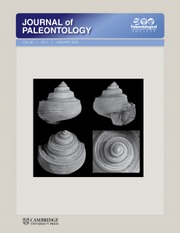Article contents
Unraveling the three-dimensional morphology of Archean microbialites
Published online by Cambridge University Press: 14 July 2015
Abstract
Fenestrate microbialites from the 2521±3 Ma Gamohaan Formation, South Africa, are composed of calcite with traces of kerogen that represent the remains of ancient microbial mats. To delineate the 3-D geometry of these microbialites, specimens were serial-sectioned; sequential slices were polished in 120 μm increments and scanned to yield an image stack, which was rendered into a virtual model of the microbialites. The resulting virtual representation allowed for visualization and characterization of microbial growth geometries that were not visible from 2-D surfaces. Several new insights into the structure of microbialites emerged from characterizing their 3-D structure including the recognition of two new features, linear structures and tubular structures. The long, thin nature of these structures makes them difficult to identify in two dimensions. However, in three dimensions, they can be traced as thin ropes of fossilized microbial communities emerging from more typical microbial mat structures. Overall, these results demonstrate a new set of microbial features in the Gamohaan Formation that were only characterized by reconstructing the full geometry of the microbialites in three dimensions.
Information
- Type
- Research Article
- Information
- Copyright
- Copyright © The Paleontological Society
References
- 12
- Cited by

